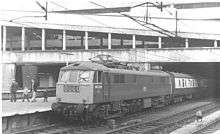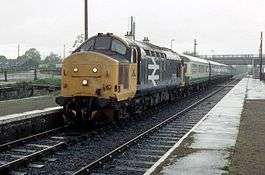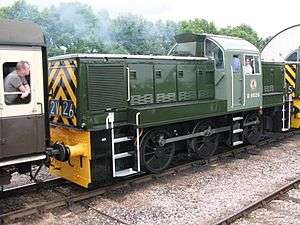Route availability




at Williton on the West Somerset Railway a low axle load and less limited R.A. of 4.

Route Availability (RA) is the system by which the permanent way and supporting works (bridges, embankments, etc.) of the National Rail network of Great Britain are graded. All routes are allocated an RA number between 1 and 10.
Rolling stock is also allocated an RA (again between 1 and 10) and the RA of a train is the highest RA of any of its elements. The RA is primarily related to the axle load of the vehicle, although axle spacing is also taken into consideration. In practice it is the locomotive which governs where trains may operate, although many high capacity 4 axle wagons have high RAs when fully loaded. (When considering the operation of trains the loading gauge must also be considered.)
Route Availability as a system was first devised by the London and North Eastern Railway, and perpetuated by British Rail to ascertain which locomotives can work on which lines throughout the rail network in Great Britain. The system uses numbers from 1 to 10 and a locomotive must have a route availability (RA) lower than or equal to the RA of a line to be allowed to work on it.
Exemptions may be obtained to allow locomotives to operate on lines from which they may otherwise be banned. An exemption might be granted by placing a speed restriction over a weak bridge, for example.
Route availability of a line
The route availability for a line is calculated taking into account bridge strength, track condition, structural issues and so on. A route availability of one (RA1) is the most restricted line, open to possibly one type of locomotive specially designed for it. A route availability of 10 is the most open, usable by any locomotive that fits within the GB loading gauge that has been 'passed' for it (checked for conflicts with infrastructure such as platforms).
Vehicle route availability
Route availability for a vehicle (locomotive or wagon) is generally based upon its axle loading. That is, how much of the laden weight of the vehicle is distributed on each axle. The more weight on each axle, the higher the RA number, and the more restricted the vehicle is. The uneven weight distribution of the class 28 Co-Bo forced the use of 6 wheel bogie at one end in order to stay within RA 8. For wagons it is normal to have different RA when running empty to full.
A locomotive with RA 1 is able to work on any line, although it will have a very light axle loading (which will limit its capabilities, for example class 01 shunters are RA 1). An RA 10 locomotive could only work upon an RA 10 line, placing restrictions on where it can be used.
The RA of a locomotive must not exceed the RA of the track except under strictly controlled circumstances.[1]
If a vehicle has wheels that require significant balance weights, in particular steam locomotives, the dynamic loading, resulting in what is termed the hammer blow action, may affect the RA of a vehicle.
Network Rail
Network Rail currently gives the allowed axle loadings as follows:[2] [3]
| Route Availability | Axle Load |
|---|---|
| RA3 | ≤16.5 tonne |
| RA5 | ≤19.0 tonne |
| RA6 | ≤20.3 tonne |
| RA8 | ≤22.8 tonne |
| RA9 | ≤24.1 tonne |
| RA10 | ≤25.4 tonne |
| EU average | ≈22.5 tonne |
The information regarding route availability (RA) on this page comes from the British Rail (London Midland Region) Route Availability Guide, and the Freight Train Loads Book, both issued in 1969. Several routes will have had their RA numbers changed since that time.
| Group Number | Mainline Classes | Shunters |
|---|---|---|
| 1 | Y14 | 01, 03, 04*, 11104, 15097 |
| 2 | 158, 220, 222 (five car) | 02, 04*, 05 |
| 3 | ||
| 4 | 15, 16, 17, 22, 221, 222 (seven car), 10800 | |
| 5 | 20, 23, 25, 27, 29, 31*, 37*, 43, 55, 185 | 06, 08*, 09, 10, 11, 12 |
| 6 | 8K, D16/2, 24, 26, 31*, 33, 35, 40, 42, 47*, 48, 50, 52*, 53, 57, 71, 73, 81, 82, 83, 84, 85, 86, 87, 89 | 07, 08* |
| 7 | 44, 45, 46, 47*, 52*, 57, 58, 59, 60, 66, 68, 70, 74, 91 | |
| 8 | 28, 67, 76 | 13 |
| 9 | ||
| 10 |
* Depending on sub-class, see individual article for details.
$ Discrepancy with original data.
Historical notes
Before nationalisation the Big Four railway companies had their own classification systems:
Great Western Railway
Each locomotive had a coloured disc painted on the cab side to indicate its route availability:
| Disc colour | Axle load (long tons & cwt) | Axle load (lb) | Axle load (t) | Notes |
|---|---|---|---|---|
| (no disc) | up to 14 long tons 0 cwt | 31,400 lb | 14.2 t | |
| Yellow disc | 14 long tons 0 cwt up to 16 long tons 0 cwt | 31,400–35,800 lb | 14.2–16.2 t | |
| Blue disc | over 16 long tons 0 cwt, up to 17 long tons 12 cwt | 35,800–39,400 lb | 16.2–17.9 t | |
| Red disc | over 17 long tons 12 cwt | 39,400 lb | 17.9 t | |
| Double Red disc | 22 long tons 10 cwt | 50,400 lb | 22.9 t | “King” class only |
See also
References
- ↑ Safety & Standards Directorate, Railtrack PLC (December 2000). "Interface between Rail Vehicle Weights and Underline Bridges - Appendix C - Flow chart of Procedure for Permitting a Train to Run" (PDF). Archived from the original (pdf) on December 11, 2007. Retrieved 2008-08-17.
- ↑ Network Rail Loading Gauge documentation
- ↑ Network Rail Route Availability
- ↑ Ransome-Wallis (1966) p.181
- Ransome-Wallis, P. (1966). The Last Steam Locomotives of British Railways. Ian Allan Limited.
External links
- British Railways Board Group Standard for Route Availability (historical)
- Network Rail infrastructure capacity
- 2D53 Introduction to Route Availability and tables
- Route availability tables for Scotland
- Network Rail Information
- GE/RT8006 Assessment of Compatibility of Rail Vehicle Weights and Underline Bridges (live issues) at RGS Online